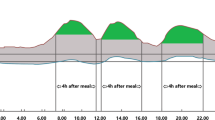Abstract
To discriminate between true secondary failure (TF) and pseudo-secondary failure (PF) to oral hypoglycaemic agents, we studied 34 non-obese non-insulin-dependent diabetic patients who were being treated with these drugs. Nine were in good control (GC) with oral treatment, while 25 showed apparent SF. During a controlled hospital diet, fasting blood glucose remained persistently high in 15 of these patients (TF), while in the other 10 patients it clearly improved (PF). Fasting plasma glucose (FPG) and HbA1c were higher and body mass index (BMI) was lower in TF patients than in PF patients (P<0.01). C-peptide concentrations differed significantly among the three groups both in the fasting state (TF 0.25±0.02 nmol/l, PF 0.70±0.03 nmol/l, GC 0.74±0.03 nmol/l;P<0.0001) and 6 min after glucagon injection (TF 0.50±0.04 nmol/l, PF 1.02±0.06 nmol/l, GC 1.14±0.07 nmol/l;P<0.0001). C-peptide and plasma insulin curves obtained after a standard mixed meal also showed significant differences (P<0.001). In particular, there was a statistically significant difference between GC and PF versus TF (P<0.05), while there was no statistical difference between PF and GC. We conclude that some patients with apparent SF can improve their metabolic control if they strictly adhere to a correct diet (PF); a single measurement of basal C-peptide concentration or examination of the C-peptide and insulin responses to a meal are useful indicators for distinguishing patients with PF from those with TF to oral hypoglycaemic agents. Lower BMI and higher fasting plasma glucose and HbA1c are additional and simple indicators of TF.
Similar content being viewed by others
References
Camerini-Davalos R, Lazano-Castaneda O, Marble A, Five years' experience with tolbutamide. Diabetes 11 [Suppl]: 74–80, 1962
Bernhard H, Long-term observations on oral hypoglycemic agents in diabetes. The effect of carbutamide and tolbutamide. Diabetes 14:59–70, 1965
Shen S-W, Bressler R, Clinical pharmacology of oral antidiabetic agents. N Engl J Med 296:787–793, 1977
Menhert H, Clinical and experimental findings after five years' treatment of diabetes with sulfonylureas. Diabetes 11 [Suppl]: 80–84, 1962
Groop L, Schalin C, Franssilla-Kallunki A, Widen E, Ekstrand A, Eriksson J, Characteristics of non-insulin-dependent diabetic patients with secondary failure to oral antidiabetic therapy. Am J Med 87:183–190, 1989
Iavicoli M, Cucinotta D, De Mattia G, Lunetta M, Morsiani M, Pontiroli AE, Pozza G, Blood glucose control and insulin secretion improved with combined therapy in type 2 diabetic patients with secondary failure to oral hypoglycaemic agents. Diabetic Med 5:849–855, 1988
Faber OK, Binder C, C-peptide response to glucagon. A test for the residual β-cell function. Diabetes 26:605–610, 1977
Gjessing HJ, Reinholdt B, Pedersen O, The plasma C-peptide and insulin responses to stimulation with intravenous glucagon and a mixed meal in well-controlled type 2 (non-insulin-dependent) diabetes mellitus: dependency on acutely established hyperglycaemia. Diabetologia 32:858–863, 1989
Heding LG, Radioimmunological determination of human C-peptide in serum. Diabetologia 11:541–548, 1975
Herbert V, Lav KS, Gottlieb GW, Coated charcoal immunoassay of insulin. J Clin Endocrinol Metab 65:1375–1380, 1965
Naka K, Yamazaki K, Yamamoto H, Development of glycosylated hemoglobin A1c auto-analyzer. J Clin Lab Automation 6:22–24, 1981
Laakso M, Ronnemaa T, Sarlund H, Pyorala K, Kallio V, Factors associated with fasting and post-glucagon plasma C-peptide levels in middle-aged insulin-treated diabetic patients. Diabetes Care 12:83–88, 1989
Hughes TA, Gwynne JT, Switzer BR, Herbst C, White G, Effects of caloric restriction and weight loss on glycemic control, insulin release and resistance, and atherosclerotic risk in obese patients with type II diabetes mellitus. Am J Med 77:7–17, 1984
Fitz JD, Sperling EM, Fein HG, A hypocaloric high-protein diet as primary therapy for adults with obesity-related diabetes: effective long-term use in a community hospital. Diabetes Care 6:328–333, 1983
Lucas CP, Patton S, Stepke T, Kinhal V, Darga LL, Carroll-Michals L, Spafford TR, Kasim S, Achieving therapeutic goals in insulin-using diabetic patients with non-insulin-dependent diabetes mellitus. Am J Med 83 [Suppl 3 A]:3–9, 1987
Laakso M, Uusitupa M, Takala J, Majander H, Reijonen T, Penttila I, Effects of hypocaloric diet and insulin therapy on metabolic control and mechanism of hyperglycemia in obese non-insulin-dependent diabetic subjects. Metabolism 37:1092–1100, 1988
Pontiroli AE, Calderara A, Pacchioni M, Cassisa C, Pozza G, Insulin requirement in elderly patients with non-insulin-dependent diabetes mellitus (NIDDM). Aging 1:147–152, 1989
Welborn TA, Garcia-Webb P, Bonser AM, Basal C-peptide in the discrimination of type I from type II diabetes. Diabetes Care 4:616–619, 1981
Katzeff HL, Savage PJ, Barclay-White B, Nagulesparan M, Bennett PH, C-peptide measurement in the differentiation of Type 1 (insulin-dependent) and Type 2 (non-insulin-dependent) diabetes mellitus. Diabetologia 28:264–268, 1985
Hother-Nielsen O, Faber OK, Schwartz Sorensen N, Beck-Nielsen H, Classification of newly diagnosed diabetic patients as insulin requiring or non-insulin requiring based on clinical and biochemical variables. Diabetes Care 11:531–537, 1988
Gjessing HJ, Matzen LE, Faber OK, Froland A, Fasting plasma C-peptide, glucagon stimulated plasma C-peptide and urinary C-peptide in relation to clinical type of diabetes. Diabetologia 32:305–311, 1989
Rendell M, C-peptide levels as a criterion in treatment of maturity-onset diabetes. J Clin Endocrinol Metab 57:1198–1206, 1983
Madsbad S, Krarup T, McNaire P, Christiansen C, Faber OK, Transbol I, Binder C, Practical clinical value of the C-peptide response to glucagon stimulation in the choice of treatment in diabetes mellitus. Acta Med Scand 210:153–156, 1981
Koskinen P, Viikari J, Irjala K, Kaihola H-L, Seppala P, C-peptide determination in the choice of treatment in diabetes mellitus. Scand J Clin Lab Invest 45:589–597, 1985
Gjessing HJ, Matzen LE, Pedersen PC, Faber OK, Froland A, Insulin requirement in non-insulin dependent diabetes mellitus: relation to simple test of islet β-cell function and insulin sensitivity. Diabetic Med 4:328–332, 1988
Pontiroli AE, Calderara A, Maffi P, Bonisolli L, Carenini A, Piatti PM, Monti LD, Gallus G, Pozza G, Illeni MT, Secondary failure to oral hypoglycaemic agents in non-obese patients with non-insulin-dependent diabetes is related to reduced insulin release. Diabetes Metab 15:79–84, 1989
Author information
Authors and Affiliations
Rights and permissions
About this article
Cite this article
Scionti, L., Misericordia, P., Santucci, A. et al. A simple clinical approach to discriminate between “true” and “pseudo” secondary failure to oral hypoglycaemic agents. Acta Diabetol 29, 20–24 (1992). https://doi.org/10.1007/BF00572824
Issue Date:
DOI: https://doi.org/10.1007/BF00572824




